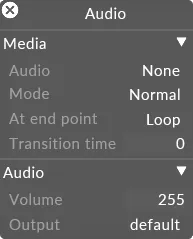Audio Layers
The Audio layer allows you to play audio files from Disguise, without the need for embedding those files into a video file first.

Workflow
Section titled “Workflow”- Add the audio files to the AudioFile folder in the Designer project folder.
- Add an audio layer to the timeline.
- Assign the layer an audio patch (assuming a logical audio out has already been configured).
Audio Layer Properties
Section titled “Audio Layer Properties”Opens the audio file list.
Normal
Section titled “Normal”When the play head stops, the audio will also stop and the frame number will lock to the timeline position. When the play head continues to play or holds at the end of a section, the audio will play continuously. Jumping around the timeline while playing does not affect which part of the audio is being played.
Locked
Section titled “Locked”If the play cursor continues to play or stops at the end of a section, the audio locks to the timeline and thus stops playing.
At End Point
Section titled “At End Point”When playback reaches the end of the video clip, the clip will loop immediately back to the beginning and will start playing again from there.
Ping-pong
Section titled “Ping-pong”When playback reaches the end of the video clip, the clip will play in reverse back to the beginning.
When playback reaches the end of the video clip, the clip will pause on the last frame.
Transition Time
Section titled “Transition Time”The transition property specifies the dissolve time, in seconds, when switching from one audio clip to the next on the timeline. By default, this is set to 0, so the player cuts immediately from one clip to the next. Setting this value to 1 causes the player to dissolve from one clip to the next over 1 second.
Volume
Section titled “Volume”You can specify any number between 0 (mute) and 255 (full) in the text field to set a constant volume, or open the properties key-frame editor to fade volume in or out.
Balance
Section titled “Balance”You can balance the playback of a file to either right or left by altering the value of the parameter.
Output
Section titled “Output”This controls which audio output device the audio is played to.